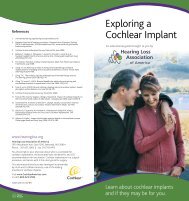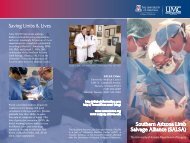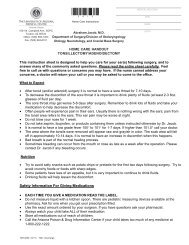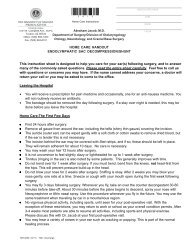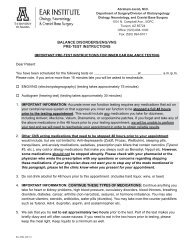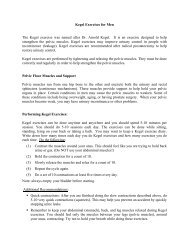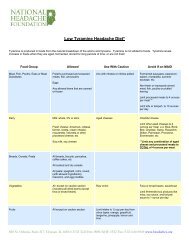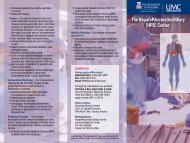Volume 10, Issue 1, 2011-2012 - Department of Surgery - University ...
Volume 10, Issue 1, 2011-2012 - Department of Surgery - University ...
Volume 10, Issue 1, 2011-2012 - Department of Surgery - University ...
- No tags were found...
You also want an ePaper? Increase the reach of your titles
YUMPU automatically turns print PDFs into web optimized ePapers that Google loves.
One Year, <strong>10</strong>0 Kidney TransplantsFelipe Pinedo, Jr.’s surgery Dec. 13,<strong>2011</strong>, marked the <strong>University</strong> <strong>of</strong>Arizona Transplant Program’s <strong>10</strong>0thkidney transplant for the year.Pinedo’s niece, Andrea Torres, 34,donated a kidney to her 57-year-olduncle, who suffered from end-stage renaldisease due to complications <strong>of</strong> diabetes.He had been on dialysis for about threeyears. Six days after the surgery, Pinedowas “raring to go,” refusing the wheelchairride to the lobby after his releasefrom the hospital.Performed at The <strong>University</strong> <strong>of</strong>Arizona Medical Center – <strong>University</strong>Campus by Rainer W.G. Gruessner,MD, and Tun Jie, MD, the year’s <strong>10</strong>0thkidney transplant is the most the hospitalhas ever done in one year. Thetransplant program performed 90 kidneytransplants in 20<strong>10</strong> and 80 in 2009. Thenumbers <strong>of</strong> lung, pediatric liver, andintestine transplants are projected to seeincreases as well.Since the program was revitalizedin 2007, about 400 kidney transplantshave been performed, 98 from livingdonors. Dr. Gruessner, chairman <strong>of</strong> theUA <strong>Department</strong> <strong>of</strong> <strong>Surgery</strong> and chief <strong>of</strong>the Division <strong>of</strong>Abdominal Transplantation,andBruce Kaplan,MD, medicaldirector <strong>of</strong> theKidney TransplantProgram,attribute some<strong>of</strong> the growth tomore live donorkidneys,<strong>2011</strong>KIDNEY TRANSPLANTSrecent advances in immunology andtechnologies, and less invasive surgicalprocedures for the donor.“We have seen a substantial increasein living donated kidneys over the pastthree years,” said Dr. Gruessner. “Withmore people on transplant lists than everbefore, leading transplant teams like oursare turning more and more to live kidneydonation.“This is good news because the lifeexpectancy <strong>of</strong> a living donor kidneyis about 20 years on average, twice aslong as a kidney from a deceased donor.Deceased donor kidneys are in very shortsupply, and there are 90,000 people waitingfor kidney transplants.”Recent advances in immunologyand technologies have allowed centersto overcome blood type and immuneincompatibility. In the past, this incompatibilitywould rule out a donor and recipientpair. The UA transplant programhas particular expertise to <strong>of</strong>fer therapiesto increase compatibility and reduce thepossibility <strong>of</strong> organ rejection.Also, new surgical techniques,including minimally invasive kidneyextraction, are making it easier to donateSince the Transplant Program was revitalizedin 2007, UA surgeons have performed about400 kidney transplants, 98 from living donors.One-year outcomes for adult kidney transplantsare higher than the national average.ComprehensiveTransplant CenterLast May, the UA <strong>Department</strong><strong>of</strong> <strong>Surgery</strong> announcedthat the UA has one <strong>of</strong> themost comprehensive programsin all areas <strong>of</strong> adult and pediatrictransplants, including:• Solid-organ transplants,which include kidney,liver, pancreas, intestine,heart, and lung transplants• Cellular transplants,which use islet cellsto treat, or evenprevent,insulindependentdiabetes• Compositetissuetransplants,includinghandtransplantsand facetransplants,forpatientswhohavesuffered limb loss orextensive facialdisfigurementa kidney to someone in need.For patients like Pinedo, a transplantprovides a better quality <strong>of</strong> lifethan the grueling three-days-a-weekdialysis treatments. They can returnto work, travel, and spend time doingthe things they enjoy.“I run racing horses with mybrothers and before the transplantI couldn’t travel with them,” saidPinedo, a retired tire store owner.“Now I can go with them.”7





